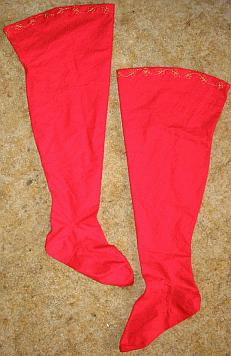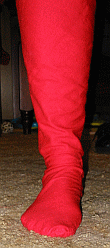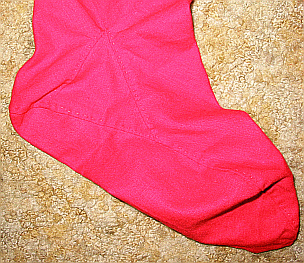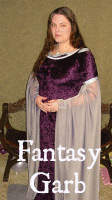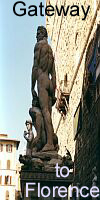


|
A pair of crimson linen calze, with gheroni
Women’s renaissance stockings, or hose were generally to
the knee or just above the knee and were footed, as seen in
Queen Elizabeth’s Wardrobe Unlock’d and A History of
Hand Knitting and Textiles and Clothing. They were could
knitted or made from cloth, cut on the bias to give stretch.
They are recorded as made from linen, silk, wool, sarcenet,
flannel. There is also mention of linings and ‘doble linen’.
It is conjectured, in Queen Elizabeth’s Wardrobe
Unlock’d, that this may have meant linen stockings lined
with linen. Dressing Renaissance Florence mentions
that the hose of the earlier Italian renaissance was made of
'perpignanao a washable, stretch woollen fabric originally
developed in France.
Eleanor d' Toledo owned mostly silk knitted stockings.
However the Gardaroba more commony lists wool cloth
stockings for Cosimo and their children (La Mode a
Firenze). Cosmio d'Medici forbade women to wear silk
stockings, in 1562. In winter, socks could be worn under the
stockings, for warmth.
Extant examples of women's stockings can be found in
Queen Elizabeth's Wardrobe Unlock'd. Both are from
the late 16th century. Pictorial representations such as
Pierto Bertelli's Cortigiana Veneza (Venetian courtesan) can
be found in Diversarum Nationum Habitus , 1591 (V&A
Museum) & 1594-1596 ( Banca dati Biblioteca
Riccardiana).
For this project, I decided to make a new pair of
stockings. This time, I will make them longer, to allow for
overlap under the drawers. Right is a drawing of my stocking
design.
|
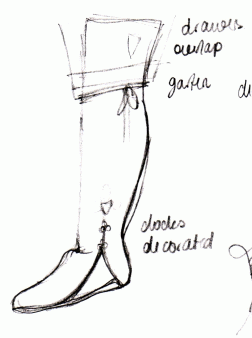
|
See my past research article on
Stockings: On Yer
Legges.
Extant Examples:
|
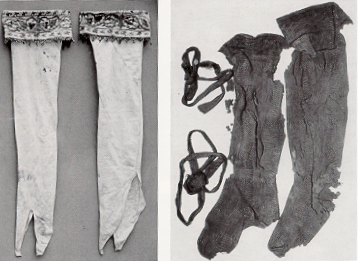
|
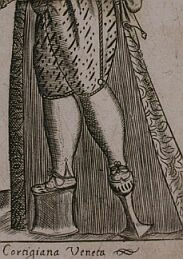
|
|
|
Extant eg. from Queen Elizabeth's Wardrobe
Unlock'd
L: Queen Elizabeth (English) & R: Eleanor d' Medici
(Italian, knitted)
|
Diversarum Nationum Habitus (Venice). Looking
below the drawers are the stockings.
|
|
Marc Carlson's website gives patterns based on
archeological finds
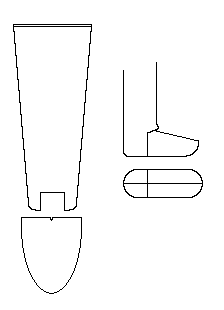
See ON YER LEGGES for more information on
stockings research
|
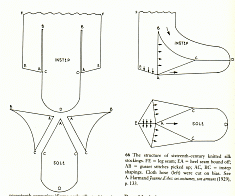
I used my basic patterns but adapted them to resemble the
patterns from A History of Hand Knitting (this also
mentions cloth hose being cut on the bias) and on the
pattern (right) is from Textiles and Clothing (p 189)
showing a 16thC hose pattern from England.
|
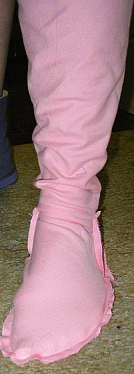
|
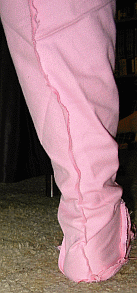
|
|
|
Here is the new toile: 1. front / 2. back seam/ 3.
inside / 4. outside/ 5. sole
|
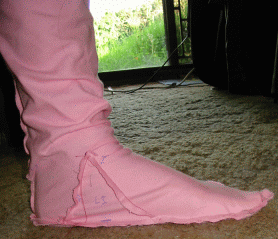
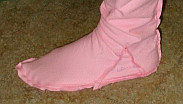
|
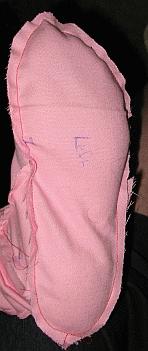
|
and the pattern resulting fomr the toile: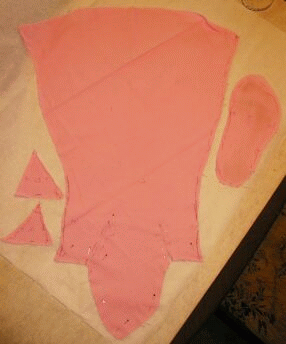
Decoration:
Some colours mentioned, in Queen Elizabeth’s Wardrobe
Unlock’d, for the stockings themselves include: carnation,
ashecolour, yellow, red, blew, tawny, orange, grene, strawe, white,
carnation, russet, black, crimson. This was mainly for English
stockings. Trimmings mentioned, in Warrant of the Robes, QEWU,
included: welted (tops) with vellat, tops stitched with Irish stitch,
stitched toppes and clockes, stitched with sondry silk colours, lace
of silke, venice gold and venice silver embroidery, red fringe,
yellow silke worke, red with red silke worke, red with yellow silke
worke, grene with sondry colours.
|
Eleanor d'Toledo's buraial stockings were of knitted red
silk. Colours used for stockings, in the first half of the
16th C (Florence), include: mostly red, white, yellow. They
could be embroidered at the top. (Gardaroba : La Mode a
Frienze).
Italian Colours (in 1300's) were recorded as scarlet, rose,
blue and 'dark'. (p45, Dressing Renaissance Florence)
and in 1515, Lorenzo d'Medici ordered turquoise cloth for
hose which were to be decorated by a 'gold-beater' with
fringing . (p106).
Right shows yellow stockings (possibly lined or with a
sock underneath) from a painting by Bernardino Luini, a
follower of Leonardo da Vinci, showing pilgrims bathing in
stream for healing.
|
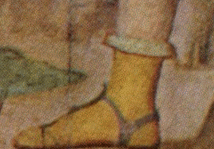
|
Many of the descriptions in the Warrant of Robes are not very
detailed as to decoration. Queen Elizabeth’s Wardrobe Unlock’d
mentions hose “of silk of sondry collors with setting on red
sarcenet lyned with red kersey”. Unfortunately there is not much
description of the actual patterns of the silke work or embroidery. I
have found even less description on Italian stockings of the era.
Common English motifs include flowers, fruits (particularly the
pomegranite) and fauna. Designs were sometimes influenced by Italian
Pattern books.
Stockings were mentioned in Ghostanza Minerbetti's Bridal Trousseau
(1511) ( Dressing Renaissance Florence), being 6 embroidered
stockings, 2 gold-embroidered stockings (p235) and two pair of
stockings 'with the family device' (p237)
Sewing & Material:
I made them in red linen, as I have problems wearing wool. Again, I
was using up material already in my stash, to keep costs down. The
material is cut on the bias. This is mentioned in Textiles and
clothing, La Mode a Firenze.
The trick to sewing stockings is to be methodical. Otherwise they
become bulky at the seams. Firstly I added the 'triangular gussets'
at the instep and outside. Then I flat-felled the seams with
hand-sewn running stitch. This is mentioned in Textiles and
Clothing, Archeological sewing. Next, I sewed the back seam,
again finishing off the seams. Finally, I put the sole on - finishing
up by flat-felling the seams. Flat-felling is important as it makes
the seams flat and not bulky. Otherwise they will be uncomfortable
when wearing them.
Here are pics of the final stockings.
1. The stockings in full
2. from the front, the new pattern gives less wrinkles
over the front of the ankle.
3. couched gold cord at the top hem
4. the new pattern with triangular gussets.
Bibliography:
Books:
- Arnold Janet, Queen Elizabeth's Wardrobe Unlock'd,
Maney, Leeds, 1988, ISBN:0-901286-20-6
- Kovesi Killerby, Catherine, Sumptuary Law in Italy
1200-1500, Oxford University Press. NY. 2002.
ISBN:0-19-924793-5
- Crowfoot E, Pritchard F & Staniland K, Textiles and
Clothing 1150-1450, Boydell Press, Woodridge, 2001 (ed) ISBN:
0-85115-840-4
- Frick, Carole Collier. Dressing Renaissance Florence.:
Families Fortunes & Clothing. John Hopkins University
Press. Baltimore. 2002. ISBN: 0-8018-6939
- Orsi Landini, Roberta & Niccoli, Bruna. La Moda a
Fioenze 1540-1580. Pagliai Polistampa, Firenze, 2005. ISBN:
88-8304-867-9
- Kohler, Carl, A History of Costume, Dover Publications,
NY,1963, ISBN: 486-21030-8
- Konig, Eberhard, Masters of Italian Art: Carravaggio,
Konemann, Cologne, 1998,ISBN: 3-8290-0243-2
- Fennel Mazzoui, Maureen. The Italian Cotton Industry in the
Later Middles Ages 1100-1600, Cambridge University press,
1981. (thanks to Galiana de Baiona).
- Rutt, Richard. A History of Hand Knitting. Interweave
Press. 1987. ISBN: 1-931499-37-3
- Willet, C. & Cunnington, Phillis, A History of
Underclothes, Dover Publications, NY, 1992, ISBN:
0-486-27124-2
Websites:
- Diversarum nationum habitus -
http://www.istitutodatini.it/biblio/images/riccard/12886/htm/vol1.htm
- Archeological Sewing by Heather Rose Jones (2001)
www.virtue.to/guest_authors/archaeological_sewing.html (5/04)
- Caerleon, Megge,Medieval Women’s Hose:
www.antir.com/meghan/hose.html (revisited: 22/7/03)
- Caerleon, Megge, Tempus Peregrinator's Sewing & Garb
Accessories Site: Bag Stockings
http://www.pipcom.com/~tempus/sewing/legs_bsocks.html (revisited:
22/7/03)
- Carlson, Marc Some Clothing of the Middle Ages.
www.personal.utulsa.edu/~marc-carlson/cloth/hose.html (24/5/03)
- Chausses and Braies:
www.randyasplund.com/browse/medieval/chausse1.html (3/11/02)
- Historical Shoe designs: Footed hose (14th -16th C):
- www.bm.com/~lindahl/carlson/SHOES/SHOES54.HTM (31/3/98)
- Kenton, Donna Flood. Hand Knit Hose. 1998:
www.dabbler.com/ndlwrk/stocking.html
- (5/8/00, revisited 22/7/03)
- McGann, Kass, The Carnamoyle Stockings — Irish Wool
Stockings from the 16th Century
- http://www.reconstructinghistory.com/irish/stocai.html
(24/5/03)
- Renaissance Tailor: Demonstrations: Stockings:
http://www.vertetsable.com/demos_stockings.htm (revisited 23/7/03)
|



|



















